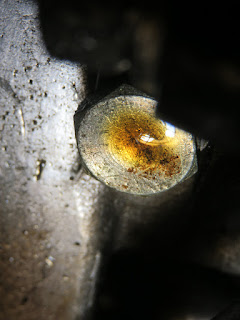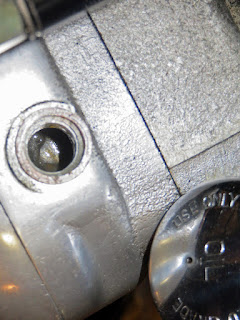 |
| Pan and absorbent paper to catch spills, wrenches and a clean, empty plastic bottle with a squirt lid. |
My gearbox is a separate unit. The transmission is not packaged to share oil with the motor, as it is in modern Royal Enfield motorcycles.
That means my gearbox oil didn't get changed every time I changed the motor oil. No. In fact, over the years, there never seemed to be any reason to change it at all!
For one thing, my old Bullet used to leak heavily from the gearbox. The side behind the primary drive mechanism — and therefore out of sight and out of reach — apparently wasn't sealed correctly.
Eventually a mechanic fixed that, fitting a proper sealing ring. But until that happened, everything I put into the gearbox was soon flung out, onto the motorcycle. What a mess.
Of course this made for the continual necessity to "top up" the gearbox with new oil. In failed attempts to keep it from pouring out I experimented with all kinds of ever thicker lubricant: Lucas oil, gear oil, grease ("elephant snot") anything that seemed likely to stay put. Of course, nothing did.
But once the seal was installed, the gearbox became virtually maintenance free. I can't remember ever draining and refilling it, in more than 42,000 miles of riding.
The time had come.
 |
| View from below: drain plug obviously leaks a bit. |
Now, only one cup of old oil came out. Probably the grease I'd shot into the thing is still in there, never to emerge. So how much oil to put back in?
 |
| Only one cup of dirty oil came out. |
 |
| Plug opening on front side of gearbox will weep oil when gearbox is at correct level. |
But what kind of oil?
I'd been "topping up" with Castrol 20W-50; conveniently enough that's the oil I use in my motor. But I'd recently read a note on the Royal Enfield Interceptor Yahoo group that gave me pause. Modern "EP" (Extreme Pressure) oils may contain additives that damage the old-fashioned gearboxes, it said.
Luckily another member of that forum immediately chimed in with this reassuring message:
"Experience shows that the original bushes tolerate the Castrol EP nicely. The EP is essential for the life of the gear-wheels! They don't stand a chance with ordinary, modern engine oil, i.e. without the EP additives. I have a box full of pitted gearwheels to prove the point."
Chris Overton, a Royal Enfield enthusiast on the Interceptor group, also assured me that I was on safe ground.
"20W-50 will work just fine, and I use it," he wrote. "Even better is 85W-140 gear oil. The product I buy here is extreme pressure (EP) and comes in a round, one-liter bottle. It has a pointy spout so you can squeeze it directly into the gearbox without using a funnel. Don't let the higher viscosity number confuse things. Engine oil like 20W-50 has viscosity measured at 300 degrees, its temperature in a hot engine. Gear oil has viscosity measured at room temperature so gives a higher number."
 |
| See why you can't use a funnel to add gearbox oil? Metal just below the opening keeps the funnel out. |
Checking, I did indeed see golden sparkles in the oil. But they were minute and I figured that they probably represented normal wear in more than 40,000 miles of city riding, with the gearbox in constant use.
So now all I had to do was refill the gearbox. First I rubbed a bar of soap against the threads of the drain plug, to provide a barrier against that slow leak I'd noticed, and reinstalled it.
Of course, my container of new 20W-50 oil doesn't have the "spout" Chris suggested. So I carefully cleaned out a plastic dish-soap container to use for squeezing oil into the gearbox. I poured my one cup of fresh oil into it and went to work.
 |
| It worked! Squeezing the plastic bottle slowly and gently inserted oil without a drip. |
But Chris was correct. My squeeze bottle shot oil into the hole under enough pressure to make the turn without backing up and overflowing. When I stopped squeezing, the plastic bottle puffed out, creating suction that practically stopped the flow of oil out its tiny nozzle, and giving the opening time to clear before I gave it another shot. A great trick!
 |
| Overflow from the side hole told me the gearbox oil was now at correct level. |
I replaced the top and side plugs and declared the job done. Now for a test ride.
But before I did that I wanted to try one more thing. Yup. If you don't want to bother using a separate squeeze bottle, as I did, the top of the soap bottle I used fits just fine on the Castrol 20W-50 container. I could have just used it to squeeze oil into the gearbox.
 |
| You can skip cleaning out a dish soap bottle and just put its lid directly on your plastic oil bottle. |


























Should be a grease filled gearbox, 700grams of '00'grade, topped up with SAE50.
ReplyDeleteMy original Enfield Model G handbook says "under no circumstances use grease in this gearbox". Don't comment if you can't back it up with evidence,
DeleteIf the author has been putting 20W50 motor oil into his gearbox, then it's little wonder that he's seeing the telltale signs of wear and damage glinting in the stuff he drained. Earlier models of those old 4-speed Albion gearboxes need a mixture of "OO" grease and a bit of heavier oil than the 20W50 he's been using. An SAE 50 monograde might suffice, but better yet an EP90 GL-4 gear oil might be preferable. Avoid any gear oil that mentions "GL-5" or "GL-2 through GL-5" on the jug, as it may contain phosphorus anti-impact additives corrosive to your old fashioned gearbox' copper or brass bits. It'll eat them like salt eats slugs. Later models of this gearbox, or those modified with a special gear oil-retaining seal, can dispense with the grease and just run EP 90 straight GL-4 gear oil. The straight GL-4 can be difficult to find nowadays on the shelves in the automotive section, but is almost always found in the boating goods section, since it is frequently used in outboard and other powerboat drives.
ReplyDeleteWhat oil is mixed with 00grade grease
ReplyDelete